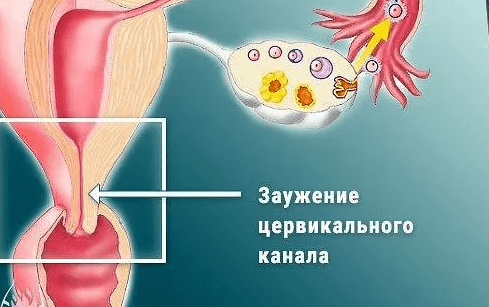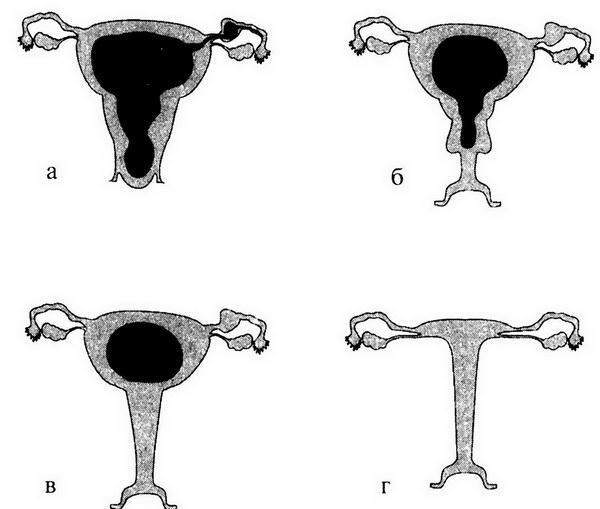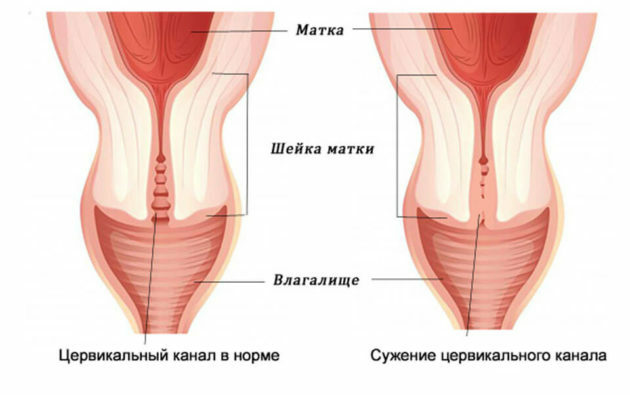Content
- 1 What is cervical atresia
- 2 Causes of cervical atresia
- 3 Symptoms of cervical atresia
- 4 Diagnostics
- 5 Treatment of cervical atresia
- 6 Possible complications and consequences
- 7 Conclusion
Among the many gynecological diagnoses, there are often diseases that are congenital in nature. As a rule, pathological formations begin even during the formation of the embryo in the womb of the expectant mother. Such diseases include atresia of the uterus and cervical canal, it can be of various types, and can also occur for a number of reasons. However, the main trigger for its occurrence are congenital pathological processes.
What is cervical atresia
Atresia of the uterus and cervix is understood as the fusion of the walls of organs, which leads to obstruction of varying degrees. The disease is characterized by certain symptoms and can lead to a number of complications.
The diagnosis of cervical atresia has different ICD codes, depending on the type:
- diagnosis specified, N88;
- unspecified - N9;
- congenital form due to abnormal development of the cervix - Q5;
- atresia caused by polyps on the neck, N1;
- if the diagnosis is caused by malignant tumors - C53.

Atresia is often caused by several causes at once, including a congenital anomaly, making diagnosis and treatment difficult
Causes of cervical atresia
Among the causes of atresia of the cervical canal, the most common are:
- Pathology that is congenital in nature, when there is an incorrect formation of the cervix even during intrauterine development. The reasons for this may be various stressful situations, infections and other adverse conditions that affect a woman during the period of gestation.
- Operations on the cervix of various types.
- Inflammatory processes occurring directly in the cervix, in the cervical canal. The lack of timely treatment of such diseases leads to the appearance of adhesions, which, in turn, cause a gradual narrowing of the lumen.
- Various cicatricial processes that occur in the cavity of the cervical canal as a result of complex childbirth.
- The presence of benign and malignant tumors that cause blockage of the canal. These include polyps, cysts, warts, etc.
- After abortion, childbirth and other gynecological manipulations, the result of which is the formation of blood clots. The latter, in turn, clog the canal, causing its anatomical narrowing.
Important! Age-related changes are a common cause of cervical atresia in menopause due to a decrease in the concentration of estrogen, accompanied by the decay of the reproductive functions. The cervical canal undergoes primary stenosis, which is a gradual narrowing, and then a blockage of the lumen occurs.
Accordingly, depending on the causes that caused atresia, it can be:
- primary, when it occurs due to pathologies of the development of the cervix;
- secondary, when the patency of the cervical canal is caused by injuries, operations, adhesive processes, etc.

Since the cervical canal has a diameter of no more than 0.8 mm, its lumen is blocked as a result of atresia almost immediately.
Symptoms of cervical atresia
The main symptom of atresia of the external os of the cervix is severe pain in the lower abdomen. They are caused by the accumulation of blood and secretions in the cavity of the organ. With the progress of the disease, discomfort increases, and may be accompanied by:
- nausea;
- vomiting;
- general malaise;
- feverish state.
Additional symptoms:
- Constipation, because the uterine cavity, filled with blood, begins to press hard on the intestines.
- Urinary retention, because the walls of the uterus put pressure on this organ.
- The appearance of signs of hematosalpinx, when the blood fills not only the uterus itself, but also the tubes with appendages. The condition is accompanied by severe pain and nausea.
- The occurrence of symptoms of pyosalpinx, when suppuration of the contents of the uterine cavity occurs. The condition is recognized by gynecology as severe, since it threatens with peritonitis, followed by blood poisoning.
If there is a partial narrowing of the lumen, the symptoms of the disease will not be so obvious. Usually this is a painful discomfort, localized in the lower abdomen, which can radiate to the lumbar region and coccyx.
Diagnostics
To identify the presence of cervical atresia, a woman needs to undergo a series of examinations. The gynecologist should determine their expediency during the initial examination.
Diagnostic measures to detect atresia:
- Colposcopy. It is an examination of the cervix using a gynecological device equipped with a special light sensor and a built-in magnifier that allows you to see the cervical cavity. As a rule, with the help of colposcopy, one can notice the underdevelopment of the cervix, as well as progressive atresia of the uterine os.
- cervical canal ultrasound. With the help of such a study, it is possible to identify the true causes of the pathological condition.
Important! Additionally, during colposcopy, it is possible to identify the presence of other causes that caused the formation of atresia - polyps, cysts and other tumors. With the help of the tool, the patency of the canal is checked along the way.
Through ultrasound, a gynecologist can determine those causes of the disease that are not visible during a simple examination on the chair:
- the presence of adhesions;
- tumors present inside the cervix;
- the presence of various obstacles, for example, blood clots;
- curvature, narrowing or underdevelopment of the cervical canal.
The presence of additional inflammatory processes will allow you to identify a smear from the cervical canal on the flora.
Treatment of cervical atresia
There are several ways to treat cervical atresia. The choice of treatment option depends on the cause that caused the appearance of the pathology.
Modern types of treatment:
- In the presence of various obstacles in the form of polyps, tumors or warts, they are surgically removed using minimally invasive methods.
- If there is a congenital underdevelopment of the cervical canal, a special operation is performed to restore the normal communication of the uterus with the rest of the genital organs.
- The presence of adhesions requires their dissection with a special tool. For this, hysteroscopy is performed.
- If it is the narrowing of the lumen that is observed, such a manipulation as bougienage is practiced. For such an operation, a special tool is used - an expander.

A timely visit to the gynecologist and regular examinations will help prevent the progression of the narrowing of the cervical canal
Atresia often manifests itself as a recurrent pathology. In this case, the installation of a special implant is shown, which will prevent further narrowing of the canal and fusion of the walls.
Possible complications and consequences
The main complication of cervical atresia is the rupture of the hematometer or hematosalpinx. This will lead to the need for emergency surgical intervention with complete drainage of the abdominal cavity. If the disease progresses, amputation of a part of the supra-vaginal uterus is often performed.
The narrowing of the canal walls is a disease that can be prevented if the following preventive measures are taken:
- Carefully plan pregnancy by doing all the necessary preliminary examinations of the body.
- Refusal of bad habits, compliance with the normal daily routine.
- All drugs should be taken only as prescribed by a doctor. Self-medication of any disease is fraught with various consequences, including fusion of the walls of the cervical canal.
- During pregnancy, it is important to exclude the influence of any negative factors, since atresia is one of the consequences of labor activity disturbed for a number of reasons.
- Pregnancy management should be carried out by a gynecologist who can identify any pathological problems at the stage of their inception.
Conclusion
Atresia of the uterus and cervix is a pathology, which is a fusion of the walls of the cervical canal. There is a disease for a number of reasons, most often it is a congenital diagnosis that requires mandatory treatment. Usually therapy is carried out with minimally invasive surgical interventions.
The information and materials on this site are provided for informational purposes only. You should not rely on the information as a substitute for actual professional medical advice, assistance or treatment.
